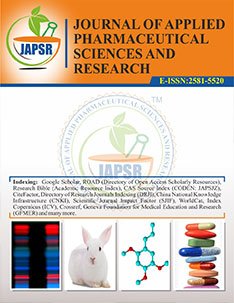EFFECT OF TERPENES AS PENETRATION ENHANCERS ON THE RELEASE AND PERMEATION KINETICS OF MELOXICAM GELS FORMULATIONS
Abstract
Introduction: The transdermal route of administration has been extensively accepted as one of the potential route for the local and systemic delivery of drugs. The greatest obstacle in drug absorption is the highly organized stratum corneum (SC), which hinder drug transport. The probable solution leads to inclusion of penetration enhancers for reversibly disorganizing the barrier characteristic of stratum corneum. Objective: The main objective of the research work was to study the influence of peppermint oil, lemongrass oil, clove oil and turpentine oil as penetration enhancers on the percutaneous absorption of Meloxicam (ME) from a Carbopol 934 based gel formulation. Materials and Methods: ME gel sample was divided into 5 batches i.e., F1, F2, F3, F4, F5. Except F1, all other batches were incorporated with penetration enhancers (5% w/w) namely peppermint oil, clove oil, lemongrass oil and turpentine oil. The formulations were further evaluated for in-vitro drug release studies using a standard cellophane membrane at 37± 0.5˚ C in phosphate buffer pH 7.4 and a comparative anti-inflammatory activity was conducted using rat paw edema method. Result and Discussion: In-vitro permeation studies using a standard cellophane membrane showed that the rank order of enhancement ratio (ERflux) for Meloxicam as peppermint oil (1.414) > clove oil (1.353) > lemongrass oil (1.326) > turpentine oil (1.272) proving peppermint oil as the most competent penetration enhancer for Meloxicam. Further In- vivo anti-inflammatory activity were carried out using the standard rat paw edema method. The in vivo studies revealed that gel containing peppermint, clove, lemongrass and turpentine exhibited 2.53, 2.0, 1.9 and 1.38 times higher anti-inflammatory effect as compared to meloxicam (standard). Conclusion: It can be concluded from the study that all the 4 terpenes significantly increases the permeation of meloxicam gels and can be used as effective penetration enhancers.
Downloads
References
2. Wester R, Maibach H. Percutaneous absorption of drugs. Clinical Pharmacokinetics. 1992; 23: 235-266.
3. Marjukka ST, Bouwstra JA, Urtti A. Chemical enhancement of percutaneous absorption in relation to stratum corneum structural alterations. Journal of Controlled Release. 1999; 59:149-161.
4. Krishnaiah YSR, Al-Saidan S, Chandrasekhar DV, Rama B. Effect of nerolidol and carvone on in vitro permeation of nicorandil across rat epidermal membrane. Drug Development and Industrial Pharmacy. 2006; 32: 423-435.
5. Williams AC, Barry BW. Terpenes and lipid-protein-partitioning theory of skin penetration enhancement. Pharmaceutical Research. 1991; 8(1): 17-24.
6. Okabe H, Takayama, K, Ogura A, Nagai T. Effect of limonene and related compounds on the percutaneous absorption of indomethacin. Drug Design and Delivery. 1989; 4(4): 313-321.
7. Substances generally recognized as safe Part 182 FDA http://www.cfsan.fda.gov//~1rd/fcf182.html/FDA 30 November, 2006.
8. Gupta SK, Bansal P, Bhardwaj RK, Jaiswal J, Velpandian T. Comparison of analgesic and anti-inflammatory activity of meloxicam gel with diclofenac and piroxicam gels in animal models: pharmacokinetic parameters after topical application. Skin Pharmacology and Applied Skin Physiology. 2002; 15(2):105-11.
9. Sharma N, Sharma S, Kaushik R. Formulation and Evaluation of Lornoxicam Transdermal patches using various Permeation Enhancers. International Journal of Drug Delivery Technology. 2019; 9(4): 597-607.
10. Shalaby S, Shukr M. The Influence of the Type and Concentration of Alcohol on the Rheological and Mucoadhesive Properties of Carpobol 940 Hydroalcoholic Gels. Der Pharmacia Sinica. 2011; 2(6):161-171.
11. Gupta GD, Gaund RS. Release rate of nimesulide from different gellants. Indian Journal of Pharmaceutical Sciences. 1991; 61:229-234.
12. William L, Remington, Science of Practice Pharmacy, 20th edition 2000, Mack Publishing Company, Easton, PA.
13. Baoa Y, Lia H, Lib Qi-Y, Lic Y, Lia F, Zhanga C, Wangd C, Yuand C. Therapeutic effects of Smilax glabra and Bolbostemma paniculatum on rheumatoid arthritis using a rat paw edema model. Biomedicine & Pharmacotherapy. 2018;108:309-315.
14. Amir Md, Ahsan I, Akhter W, Khan A, Ali I. Design and Synthesis of some azole derivatives containing 2,4,5- triphenyl imidazole moiety as antiniflammatory and antimicrobial agents, Indian Journal of Chemistry. 2011; 50:207-213.
All the articles published in JAPSR are distributed under a creative commons license (CC BY-NC-SA 4.0)
Under this license, you are free to:
- Share- copy and redistribute the material in any medium or format for any purpose, even commercially.
- Adapt- remix, transform, and build upon the material for any purpose, even commercially.
The licensor cannot revoke these freedoms as long as you follow the license terms.
- Attribution — You must give appropriate credit , provide a link to the license, and indicate if changes were made . You may do so in any reasonable manner, but not in any way that suggests the licensor endorses you or your use.
- NonCommercial — You may not use the material for commercial purposes .
- ShareAlike — If you remix, transform, or build upon the material, you must distribute your contributions under the same license as the original.
- No additional restrictions — You may not apply legal terms or technological measures that legally restrict others from doing anything the license permits.
Copyright policy
The journal allows the author(s) to hold the copyright of their work. That means the authors do not need to transfer the copyright of their work to the journal. However, the authors grant JAPSR a license to publish the article and identify itself as the original publisher.
Licensing policy
The journal allows the author(s) to hold the copyright of their work. That means the authors do not need to transfer the copyright of their work to the journal. However, the authors grant JAPSR a license to publish the article and identify itself as the original publisher.






